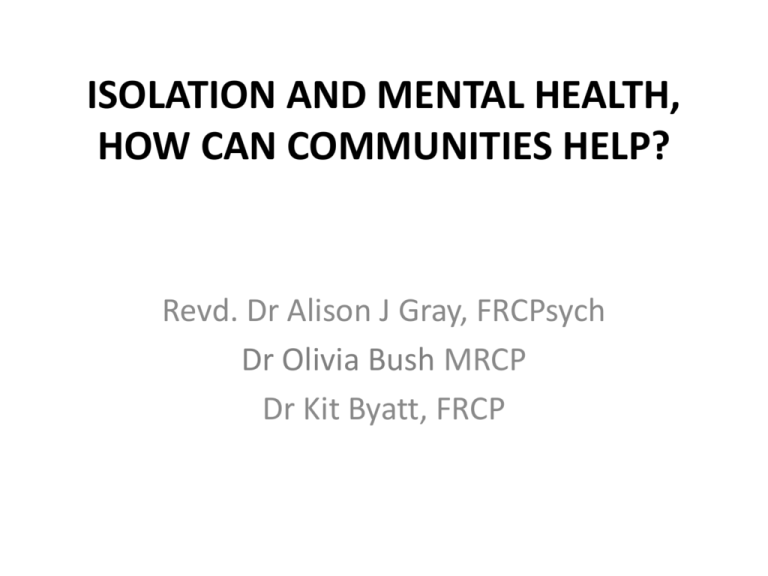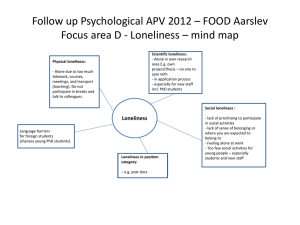Presentation
advertisement

ISOLATION AND MENTAL HEALTH, HOW CAN COMMUNITIES HELP? Revd. Dr Alison J Gray, FRCPsych Dr Olivia Bush MRCP Dr Kit Byatt, FRCP The Context Revd. Dr Alison Gray FRCPsych Consultant in Liaison Psychiatry 2gether NHS Mental Health Trust Types of loneliness • Emotional loneliness • Social loneliness Social Support cannot fully compensate Why Loneliness ? • • • • Makes parents care for children Homeostatic mechanism Different set points 50% genetic Loneliness cycle • • • • • Lonely people are sensitive to social threat Expect to be rejected Respond negatively Act difficult More lonely Stress, support and physical symptoms Chronic loneliness linked to… • • • • • • Lower self control Obesity, poor diet, lack of exercise, Worse physical health Stroke, heart attack, cancer Worse mental health Dementias, Alzheimer’s disease, vascular dementia, • Depression, anxiety, suicide Biological effects • • • • • Increased blood pressure Stress hormones Low immunity Inflammation Poor sleep Loneliness cycle • • • • • Lonely people are sensitive to social threat Expect to be rejected Respond negatively Act difficult More lonely Mental illness • Difficult to be with • People expect Challenging behaviour BUT Severe and enduring mental illness Charles Darwin, Florence Nightingale, Winston Churchill, Abraham Lincoln, Vincent Van Gogh, Virginia Woolf, Buzz Aldrin, Charles Dickens, Isaac Newton, Leo Tolstoy, Ernest Hemingway, Sylvia Plath, Mark Twain, Edgar Allen Poe Bradley Wiggins, Ricky Hatton, Carlos Tevez, Frank Bruno, Mario Ballotelli, Stan Collymore, Serena Williams, Andy Cole, Neil Lennon, Paul Gascoigne, Clark Carlisle, Dean Windass, Andrew Flintoff, Tasha Danvers, Kelly Holmes, John Kirwan, Paul McGrath Kirsten Dunst, Carrie Fisher, Robin Williams, Steven Fry, Bill Oddie, Elton John, Janet Jackson, Kurt Cobain, MP’s John Prescott, David Blunkett, Charles Walker, Kevan Jones, Sarah Woolaston • Mental illnesses are common • One in Four • Every family in the Land • No health without mental health Loneliness kills: 9 years follow up The Evidence Dr Olivia Bush MRCP Specialist Registrar in Palliative Care St Richard’s Hospice, Worcester Action to reduce loneliness • Immense number and variety of projects • Recent study drawing evidence together Focus of projects Groups or 1-2-1 Focus of projects Groups or 1-2-1 work: a) Social skills b) Social support c) Social contact a) ‘Loneliness cycle’ Focus of projects Groups or 1-2-1 work: a) Social skills b) Social support c) Social contact a) ‘Loneliness cycle’ Focus of projects Groups or 1-2-1 work: a) Social skills b) Social support c) Social contact d) ‘Loneliness cycle’ Focus of projects Groups or 1-2-1 work: a) Social skills b) Social support c) Social contact a) ‘Loneliness cycle’ For whom? For whom? • different Age groups For whom? • different Age groups • Displaced For whom? • different Age groups • Displaced • Marginalised For whom? • • • • different Age groups Displaced Marginalised specific Role For whom? • • • • • different Age groups Displaced Marginalised specific Role Gender specific For whom? • • • • • • different Age groups Displaced Marginalised specific Role Gender specific Mental health For whom? • • • • • • • different Age groups Displaced Marginalised specific Role Gender specific Mental health Other diagnoses What works best? What works best? • Targeting the ‘loneliness cycle’ most effective What works best? • Targeting the ‘loneliness cycle’ most effective • Men benefit more than women What works best? • Targeting the ‘loneliness cycle’ most effective • Men benefit more than women • Is social support/interaction effective? What works best? What works best? • Group education/ activity • Target specific groups • More than one approach • Participant’s voice Cattan et al 1998 & 2005 What works best? • Group education/ activity • Target specific groups • More than one approach • Participant’s voice Cattan et al 1998 & 2005 What works best? • Group education/ activity • Target specific groups • More than one approach • Participant’s voice Cattan et al 1998 & 2005 What works best? • Group education/ activity • Target specific groups • More than one approach • Participant’s voice Cattan et al 1998 & 2005 Care interpreting research! • Bias • Applicable to real-life situation? Key Messages • Good practice to start with research evidence • Don’t accept research findings at face value Where next? Dr Kit Byatt FRCP Consultant in General and Geriatric Medicine Wye Valley NHS Trust Key points ‘…an individual may be lonely in a crowd or socially contented while alone.’ Masi et al. Personality and Social Psychology Review 15(3) 219–266 ‘Because the number of friends or social interactions is not as predictive of loneliness as the quality of their relationships, increasing opportunities for social interaction and enhancing social support may address social isolation more than loneliness.’ Masi et al. Personality and Social Psychology Review 15(3) 219–266 ‘In contrast, improving social skills and addressing maladaptive social cognition focus on quality of social interaction and therefore address loneliness more directly.’ Masi et al. Personality and Social Psychology Review 15(3) 219–266 • Users liked flexibility & adaptation of services • Interventions include: – Befriending – Mentoring – ‘Community Navigators’ – Social group schemes Masi et al. Personality and Social Psychology Review 15(3) 219–266 • • • • Identifying target Asking what people want Evaluating impact Governance structure Masi et al. Personality and Social Psychology Review 15(3) 219–266 ‘If schemes to target loneliness in older people are to be effective, they must involve older people at every stage, including planning, development, delivery and assessment.’ Masi et al. Personality and Social Psychology Review 15(3) 219–266 NHS Five Year Forward View http://www.england.nhs.uk/ourwork/futurenhs/ ‘New Models of Care’ We need to: • Manage systems – care networks – not organisations • Make out-of-hospital care much larger part of NHS’ role • Integrate services around the patient • Learn much faster from best examples (UK & outside) • Evaluate new care models http://www.england.nhs.uk/ourwork/futurenhs/ p16 Engaging communities • Commit to giving patients more control of their own care, including the option of combining health and social care, and new support for carers and volunteers. • Action needed to develop and deliver the new models of care, local flexibility and more investment in our workforce, technology and innovation. http://www.england.nhs.uk/ourwork/futurenhs/ p3 One size fits all? ‘to identify the characteristics of similar health communities across England, and then jointly work with them to consider which of the new options… constitute viable ways forward for their local health and care services.’ http://www.england.nhs.uk/ourwork/futurenhs/ p18 Multispecialty Community Providers ‘These new models would also draw on the ‘renewable energy’ of carers, volunteers and patients themselves, accessing hard-to-reach groups and taking new approaches to changing health behaviours.’ http://www.england.nhs.uk/ourwork/futurenhs/ p19 How will we support these new care models? ‘We will therefore now work with local communities and leaders to identify what changes are needed in how national and local organisations best work together, and will jointly develop:’ http://www.england.nhs.uk/ourwork/futurenhs/ p25 How will we support these new care models? ‘Detailed prototyping of each of the new care models described above, together with any others that may be proposed that offer the potential to deliver the necessary transformation - in each case identifying current exemplars, potential benefits, risks and transition costs.’ http://www.england.nhs.uk/ourwork/futurenhs/ p25 How will we support these new care models? ‘A shared method of assessing the characteristics of each health economy, to help inform local choice of preferred models, promote peer learning with similar areas, and allow joint intervention in health economies that are furthest from where they need to be.’ http://www.england.nhs.uk/ourwork/futurenhs/ p25 Whatever we do… …must be: • Planned – with users • Integrated with current systems • Properly implemented • Evaluated re outcomes • Within a governance framework






